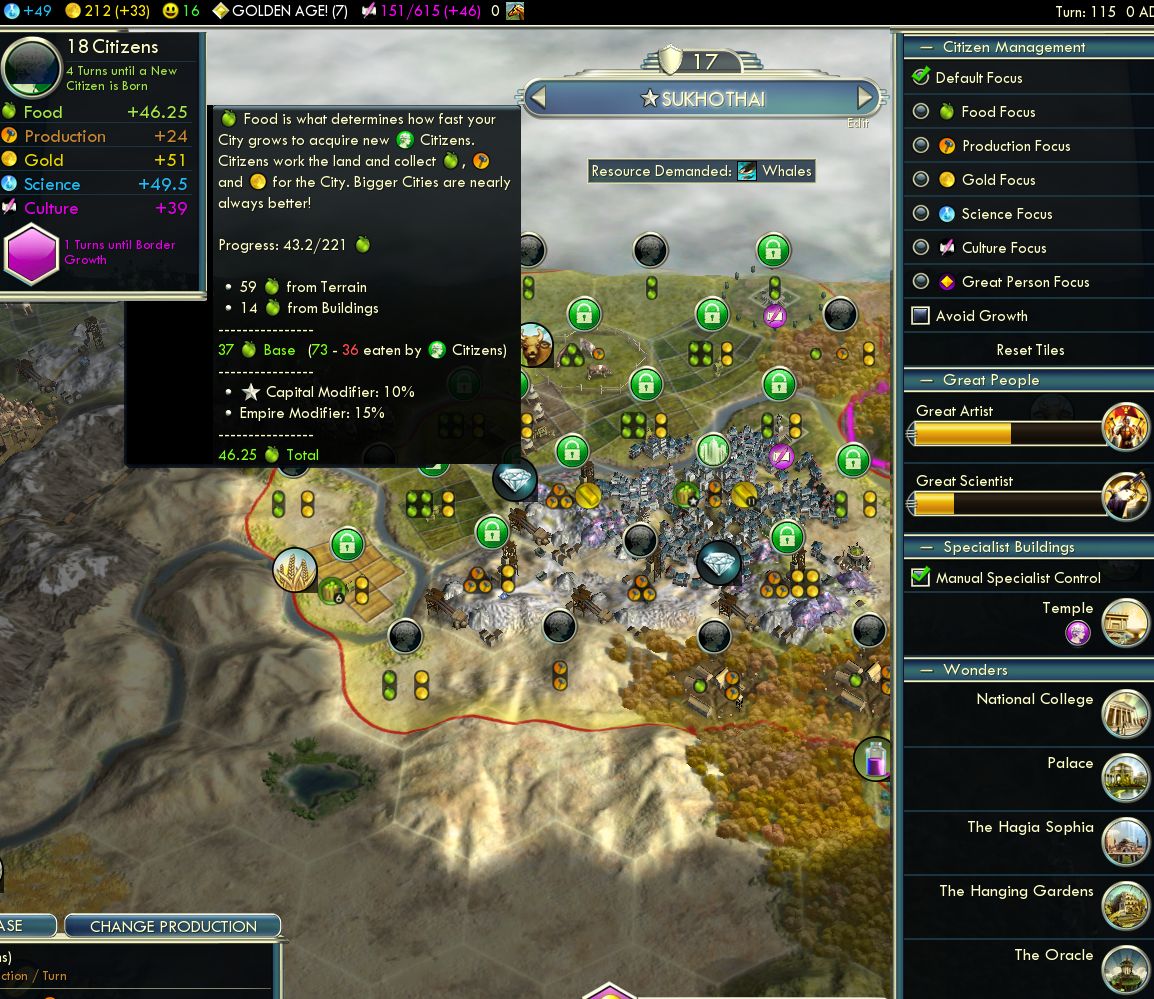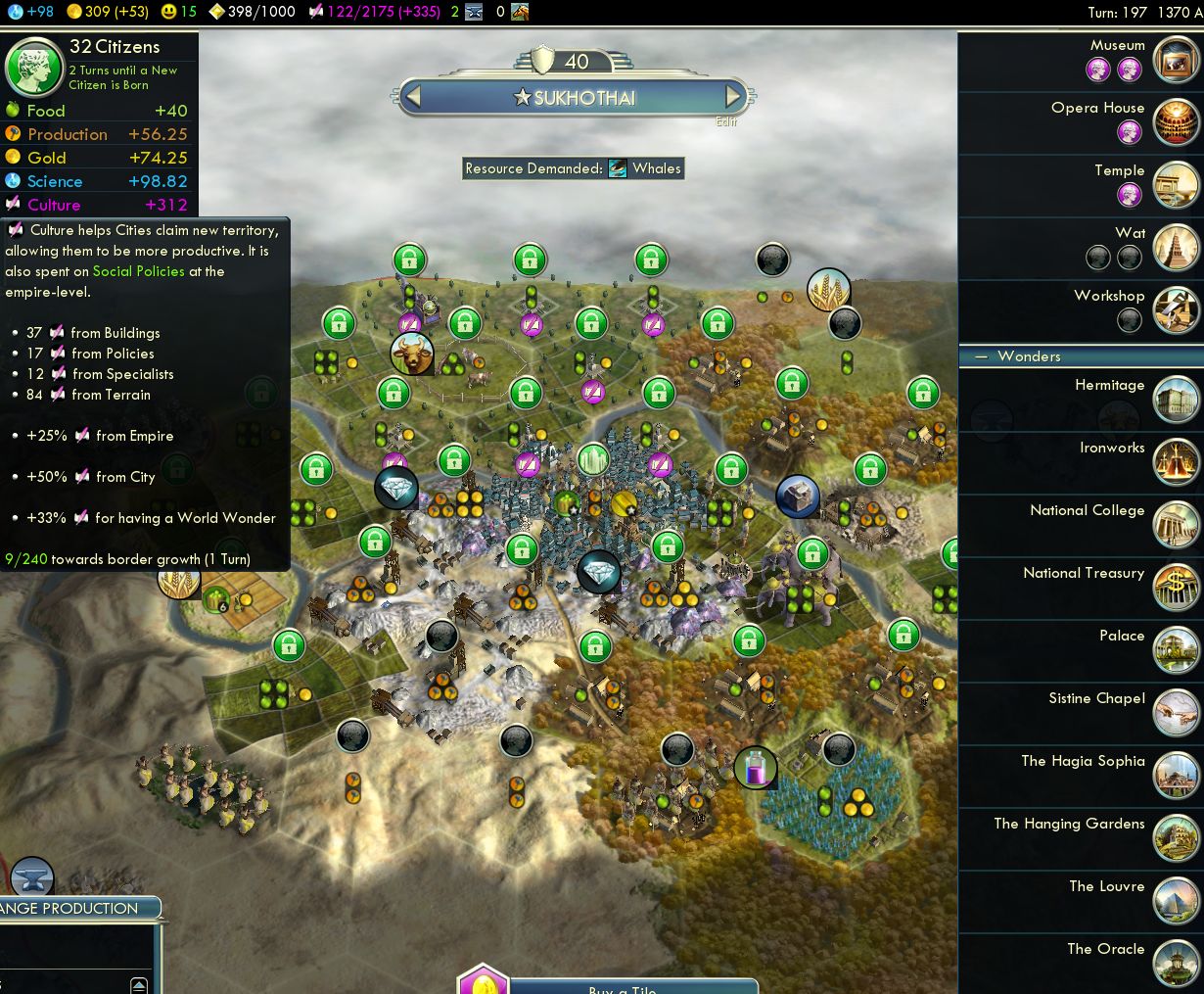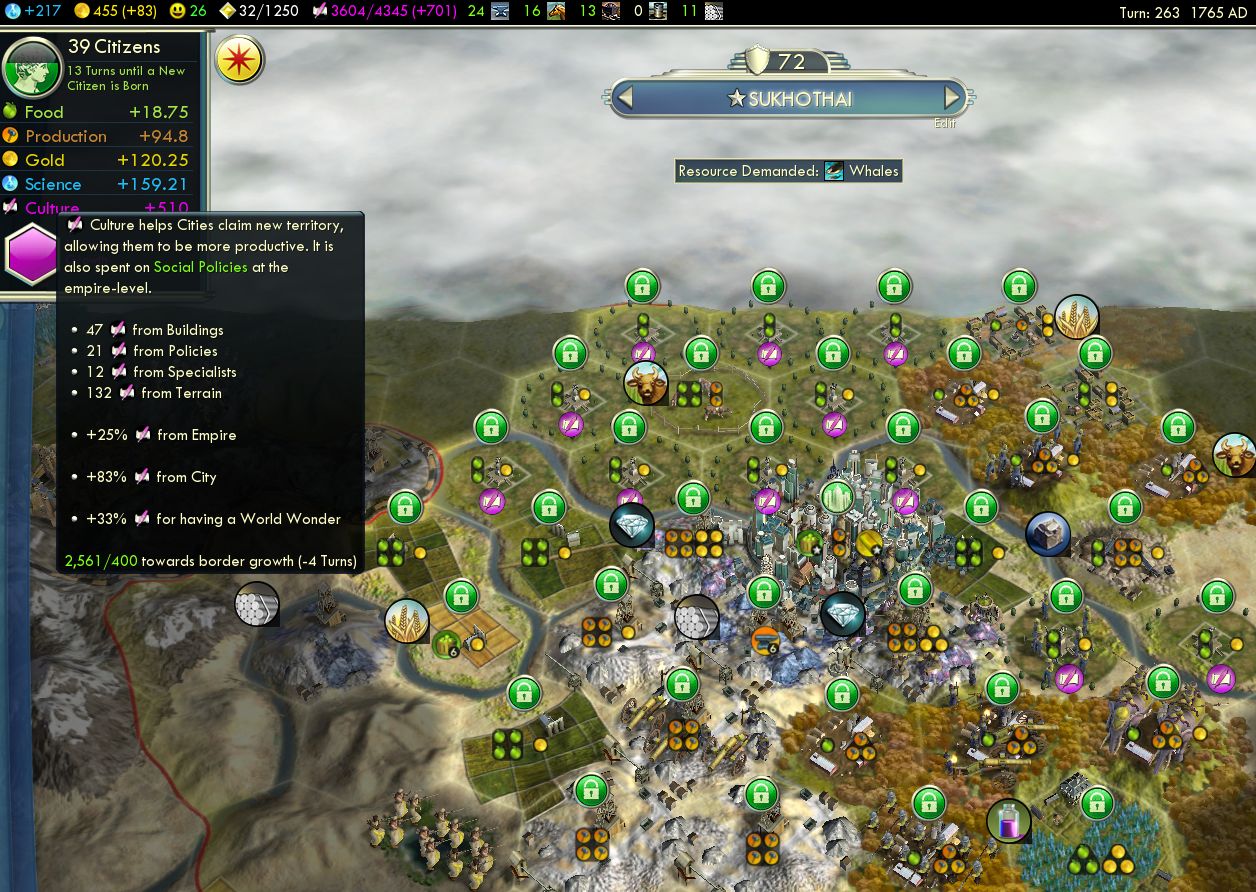
Here's a look at the traditional date of the calendar changeover. (Er, 0 AD, not 1 AD? ![]() ) Holy crap, +45 food and size 18. I recorded my build order here as Oracle - Temple - Hagia Sophia - Stone Works - National College - pikeman - Garden - Wat - Porcelain Tower. Of course that shows that my tech path was Civil Service and then Education, which of course is what you do in the vast majority of Civ 5 games. Education was timed nicely with the Reformation policy, using the Golden Age hammer bonus for the university and PT.
) Holy crap, +45 food and size 18. I recorded my build order here as Oracle - Temple - Hagia Sophia - Stone Works - National College - pikeman - Garden - Wat - Porcelain Tower. Of course that shows that my tech path was Civil Service and then Education, which of course is what you do in the vast majority of Civ 5 games. Education was timed nicely with the Reformation policy, using the Golden Age hammer bonus for the university and PT.
A decent chunk of that food was from city-states, as you can see that the city center there shows over 10 food with the little star icon. With Monarchy for gold, and an easy quest from Cape Town (connect a road, which I then immediately dismantled of course), I'd been able to continue buying maritime friends and now had three.
And I'm doing all that without We Love The King Day: notice the terrible roll of Whales for that. On this Inland Sea, there were only one or two sources of whales in existence, none within reach of a city-state. I was never able to acquire whales the whole game - this city could have gone even crazier over-the-top with WLTKD.
Research up through the Chivalry branch was next, timed with the standard play of the Porcelain Tower. This bulbed Acoustics at turn 132, 425 AD, and Sukhothai started right away on the Opera House and Hermitage.
So now Freedom was available after I had three Piety policies after the opener. But it was correct to finish Piety first, since the last two policies come two-for-one. Free Religion (and Theocracy for free) cost 775 culture, but the -10% discount would pay for that before Freedom was finished.
I'm starting to dislike this aspect of culture victories in Civ 5. You ALWAYS have to start and finish Piety early, because of that discount. But Piety doesn't really DO much by itself, just acts as a "drive-through" that hurries you onto other trees. Piety is never worthwhile for anything other than a culture victory. Any policy that produces culture never ever works out mathematically to catch up to its own exponentiation to all future policy costs. And Rationalism gives much more payoff anyway.
More generally, I had figured that the social policies would pack some decent replay value into Civ 5, but now I'm discovering that the paths really vary very little. Liberty is always first if not OCC. For any culture game, Tradition, Piety, and Freedom are mandatory. Rationalism, Order, and Autocracy are therefore blocked. Honor doesn't help. That leaves either Patronage or Commerce as the only actual decision (or both in OCC), but the choice doesn't even matter when these policies arrive in the last couple dozen turns of the game. And when you're not playing for culture, you only tend to get about 10 or 12 policies total, and half of those fill Liberty. That leaves precious little variety indeed.
Anyway, Freedom was my third area here. I took the opener on T148 760 AD and finished the tree on T197 1370 AD.
After the Hermitage, my city finally paused on culture to fill in some essentials. Workshop and Ironworks, Aqueduct, Market and National Treasury, and one Naresuan's Elephant to go chase down barbarians and spawn my Great General. Then back to work on the Sistine Chapel.
I ran scientists for two Great ones, then slowed the scientist GPP to let all the rest be artists. The first of the two GS bulbed Archaeology and the second saved for Radio.
My cash income presently kicked into high gear, with the National Treasury, then the Free Speech policy. That one is seriously underrated, 8 free units means savings of like 20 gpt now and ramping up to over 30 later. That's better than you get from any other policy that makes money, like Monarchy or the Commerce opener or Trade Unions. Problem is that Free Speech is stuck behind Constitution (+2 culture per wonder), which is useless as it does nothing else and can never recover its own cost.
Anyway, with the extra money, I finally started signing some research agreements. I was noticing that a single city can't research very well; my Sukhothai barely crested 100 beakers, a far cry from the 800+ of my Korea civ in the last game. But a single city can produce cash pretty well thanks to Monarchy, and of course cash turns into beakers with research agreements.
Apologies for the wall of text, but there wasn't a whole lot of interesting happening. Nobody declared war on me. My neighbors on the Inland Sea map were the Aztecs and Babylon. I signed Friendship with both of them and nobody else, and never got bothered. Sukhothai just kept growing, sustaining 50 food/turn for a very long time and shooting quickly into the thirties on size. I built Taj Mahal, mostly because one of the cultured city-states wanted it so it was worth several hundred gold of influence. The Golden Age was more worthwhile than I'd thought, having forgotten that the Freedom finisher would lengthen it. I also got a total of three happiness Golden Ages throughout the game. (Monarchy in an OCC really means absolutely no constraint on happiness, ever.)

So here's another picture. This is the big inflection point of the culture game, when Freedom finishes and the Louvre artists get settled. That's 335 culture/turn, drilling through policies in 7-8 turns each. Seven Landmarks are providing the bulk of the production.
Although my actual research was quite slow (20+ turns per tech), the aforementioned Research Agreements kicked in and catapulted me into and through the industrial age quickly. I bulbed Telegraph with the saved GS and built Cristo Redentor, with one more RA then adding Radio for the Broadcast Tower. Now I was done researching (no Sydney Opera House with no coastal city), so now cash went entirely into buying cultured city-states. There were five on the map and I soon had them all allied.

Although something was wrong with Siam's mechanic. Allied city-states are worth 26 culture each in the industrial age, and I had three at the time of the picture. That should have added up to 78 cpt base, with Siam's bonus adding 50% for 117 total. No matter how I arrange any of the numbers, there's absolutely no way for any number of city-states to make 82 cpt. What's going on here?
Anyway, I picked Commerce as my fifth tree, but only then realized that it was entirely blank past the opener. No coastal cities, no navy, no roads, and no happiness needed! Should have done Honor, if only to spend the GG on a Golden Age.
 One more Great Scientist spawned late (couldn't stop the scientist GPP), who bulbed Electronics to make some mechs for defense. Babylon did finally declare war on me very late, which I obliterated with mechs and artillery against cavalry. After two Babylonian city razes, he buckled for peace.
One more Great Scientist spawned late (couldn't stop the scientist GPP), who bulbed Electronics to make some mechs for defense. Babylon did finally declare war on me very late, which I obliterated with mechs and artillery against cavalry. After two Babylonian city razes, he buckled for peace.

And a last view as my city reached full size. 39 citizens, working 35 of the possible 36 land tiles (one desert snuck in there) plus the four artists. Pretty nice place. Moving on, turn 285 brought my last policy. Utopia Project finished and victory on turn 296.

So that was a nice satisfying 50 turns faster than my original culture foray with Japan. There is some current on Civfanatics that a single city is the best way to play for culture victory, and I'm inclined to agree. A great advantage of OCC is the ability to skip the Liberty tree to drill through Tradition rapidamente, picking up the food multipliers in the second millennium BC, while Monarchy obliterates anger problems. And a single super city cuts time off the early game with easy national wonders and the end game with a fast build for Utopia.
I haven't run through the math in detail, but it does seem that more cities can't add any velocity towards the culture win. What they do provide is resilience in building units for defense, and cash for research agreements. But if you never get attacked, and possesss lots of riverside tiles for cash, one city is all you need.